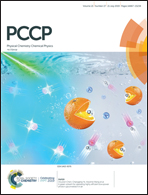Revealing the distinct mechanistic binding and activity of 5-(1-(3,5-dichloropyridin-4-yl)ethoxy)-3-(5-(4-methylpiperazin-1-yl)-1H-benzo[d]imidazol-2-yl)-1H-indazole enantiomers against FGFR1
Abstract
The concept of chirality has become prominent over the years, particularly with regards to the design of therapeutic molecules. This phenomenon was recently reported for pro-carcinogenic fibroblast growth factor receptor 1 (FGFR1), wherein two inhibitors exhibited disparate inhibitory potencies due to the effects of chirality. Therefore, the ability of the R-enantiomer (R-21c) to possess a potency 10.44 times that of the S-enantiomer (S-21c) leaves us with a curiosity to investigate the underlying mechanisms using computational methods. Hence, presented in this study are insights that clearly explain the systematic effects of chirality on the differential activities of (R)-21c and (S)-21c towards FGFR1. The findings showed that the “R-configured” (R)-21c induced a notable conformational change in the active site P-loop, which enhanced its motion, as complemented by rotation of two dihedral angles: φ1(CNCC) and φ2(CC*OC), providing a favorable orientation. Likewise, optimal positioning of (R)-21c at the binding cavity allowed adequate interspaces that facilitated the formation of strong interactions with target residues. Moreover, the estimated ΔG binding correlated with bioactivity data (IC50) and, when decomposed, we observed that van der Waals (vdW) interactions were the major highlight of the binding process of both 21c enantiomers and also accounted for their differential activities. Active site interactions of (R)-21c with residues Phe489 and Arg629 stabilized its two benzimidazole motifs, while Arg570 and Pro663 formed two strong N⋯H–N hydrogen bonds and one π-alkyl interaction, which altogether accounted for its inhibitory prowess towards FGFR1. In contrast, these interactions were not observed in (S)-21c due to its non-flexible S-configuration, which disallowed its extension into the active site region and prevented interaction with crucial residues. These results are expected to facilitate the discovery and rational design of novel and specific FGFR1 inhibitors.
![Graphical abstract: Revealing the distinct mechanistic binding and activity of 5-(1-(3,5-dichloropyridin-4-yl)ethoxy)-3-(5-(4-methylpiperazin-1-yl)-1H-benzo[d]imidazol-2-yl)-1H-indazole enantiomers against FGFR1](/en/Image/Get?imageInfo.ImageType=GA&imageInfo.ImageIdentifier.ManuscriptID=C9CP02112D&imageInfo.ImageIdentifier.Year=2019)


 Please wait while we load your content...
Please wait while we load your content...